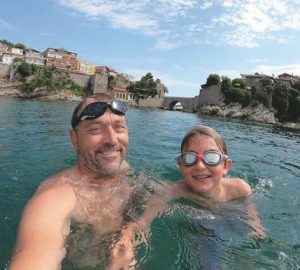Is drafting over-rated?
Elite swimmers race in packs for a simple reason. If you swim behind and to the side of another swimmer, or directly behind them, you can swim faster for less effort. There’s no doubt that drafting can help you swim quicker but, in an open water event, should our default position be to swim in someone else’s wake?
I think, not necessarily.
The major benefit of drafting is that you can swim faster than your regular pace, or you can maintain your regular pace with less effort. If you trust the person in front to follow the correct swim route, you may also get away with sighting less
If you’re in a race and you’re after the prize money or prestige that comes with a fast time or good finishing position, by all means go ahead and draft, and swim faster. Likewise, if you’re in a triathlon and your finishing position is important (isn’t it always in triathlon) then stick on someone’s feet and conserve energy for the bike and run.
But, as open water swimmers, it’s possible we might have other goals than a fast finishing time, like having a pleasant swim or enjoying our surroundings, and drafting can spoil that for you. Here are some other reasons why drafting might not be for you.
- Drafting well is a skill, and like most skills has to be learnt and practised. There may be other things you’d rather spend your precious time in the water doing.
- Drafting is hard work. Yes, you can swim faster but you have to stay mentally alert and focused to maintain your position. You tend to swim in rougher water and you may have to fight to defend your position against other people that want your drafting spot. It’s also harder to see where you’re going and know where you are.
- You can swallow a lot more water than when swimming in clear water
- Your pace is determined by those in front of you so you lose your choice. You will also waste energy keeping up with pace changes.
- You are more likely to be kicked, punched, scratched of swum over, even if nobody is intentionally trying to hurt you.
- The person leading you may suddenly veer to one side or the other. If you’re swimming to the side they turn to you may get hit. If you’re swimming behind you have to choice whether to hold your line or follow their weaving, often without knowing why they’re changing direction.
- At a turn you can be forced into taking a much wider line than you’d like to, or you can be squeezed into a corner.
- You often can’t maintain your natural rhythm or stroke rate. This might just be annoying or uncomfortable, or it might exhaust you.
- It annoys the person in front, especially if you keep tapping their toes.
- If you’re swimming in very rough water then the waves can throw you about a bit. You might be better off giving yourself a bit more space to avoid being flung into another swimmer.
The main point, I guess, is that if you’re swimming for pleasure or personal challenge rather than speed and medals, then drafting might not be for you. However, a lot of people, perhaps who’ve spent a lot of time reading triathlon publications, or who have come from a triathlon background, seem to adopt drafting as a default in open water swimming. It is possible for the majority of people to complete the distance without being dragged along by someone else, so why make your swim less pleasant for the sake of a few seconds or a slightly lower number against your name on the finishers list?
The other thing that annoys: if you go to a lake where swimming is organised – i.e. you pay money and there is a course marked out to follow – why do complete strangers start swimming on your feet? If you want to practise drafting, do it with your friends or training buddies rather than someone you don’t know.






